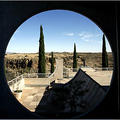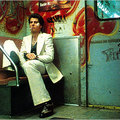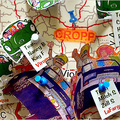
Andrew Hancock for The New York Times
Gary Bartlett's 1957 Jaguar is the only XKSS that has never been restored.
Pebble Beach, Calif.
WHEN it came time to freshen up Michelangelo’s “David” a few years ago, a spirited debate broke out over which restoration process would be most appropriate for the priceless artwork. Though the cleaning techniques under consideration varied widely in their aggressiveness, it is safe to assume that no conservator recommended sandblasting the 14-foot tall hunk of marble to remove the centuries of accumulated grime.
A similar reverence for original finishes and the patina of time is developing among collectors of classic cars, an appreciation for automobiles that have been well preserved through the years rather than restored to showroom (or better) condition.
One sign of the evolving attitudes can be seen at the Pebble Beach Concours d’Élégance, taking place here today on the Monterey Peninsula. Considered the premier American concours, Pebble Beach added a Preservation Class for unrestored prewar cars in 2001; this year, a second Preservation Class, for unrestored postwar cars, is included.
The new class is a validation of the values held dear by collectors like Gary Bartlett of Muncie, Ind., who owns one of the most significant unrestored postwar cars, a 1957 Jaguar XKSS. One of 16 built before a factory fire ended production, it was the ultimate supercar of its era, essentially a street-legal version of the D-Type Le Mans racecar, and a favorite of celebrity playboys.
Mr. Bartlett purchased the Jaguar at a 1998 Christie’s auction, virtually untouched from new — a time capsule — and the only one of the 16 XKSS’s that had never been restored. The car, which was displayed at the 1957 Chicago Motor Show, had been all but given up for lost. In fact, it was hiding in plain sight, still in a garage, still in Chicago and in the hands of the second owner who had bought it in 1960.
Sloppy handwriting had resulted in the misreading of the owner’s last name and sent searchers on wild goose chases over the years. A dealer of rare cars, contacted by the second owner, took charge of the XKSS and consigned it to the Christie’s auction in London.
Externally, the car is exactly as it appeared in Chicago in 1957. The paint, the interior and even the tires, convertible top and top cover are original. Naturally, the car has a patina but it is utterly authentic and remarkably well preserved. Mr. Bartlett had the mechanical systems inspected and reconditioned as needed with original parts.
As a comparatively new pursuit, car collecting has yet to adopt the guidelines typically followed by collectors of other historic objects. Europeans have been a bit ahead of the curve on this; the mandate of the Fédération Internationale des Véhicules Anciens, founded in 1966 in France, is to identify and classify vintage vehicles of all types and to assist in sorting out the differences among vehicles that are original, reproductions or fakes. No equivalent organization exists in the United States.
Tom Cotter, co-director of the Amelia Island Concours d’Élégance, a major show held in Florida each March, said he thought the psychology of car collectors was somewhat different from that of other collectors. Cars are an expression of one’s personality, and “car collectors are often perfectionists who simply cannot resist putting their thumbprint on a car,” he said.
“The first thing a lot of car collectors want to do when they buy a car is to tear it apart and make everything like new and to their particular preference.” That is understandable, he said, because cars, unlike most other types of collectibles, are actually used.
Collectors and preservationists outside the old-car hobby take exception to “better than new” restorations that result in cars finished to a level of perfection no production line could have achieved. According to Linda Edquist, a conservation specialist at the National Postal Museum of the Smithsonian Institution, the prime directive among preservationists is to do no harm.
The Smithsonian’s philosophy of preservation and conservation — among other things, knowing when to leave well enough alone — clearly resonates with Bloomington Gold, an organization based in Normal, Ill., that certifies vintage Corvettes based on levels of authenticity and preservation.
David Burroughs, founder and chief executive of the organization, said that cars were among the few collectible objects for which refinishing generally did not have a negative effect on value. “With nearly any other collectible object you can think of, whether it is a coin, a stamp, a piece of furniture or a firearm, refinishing harms the value.”
Mr. Burroughs recounts with a sense of resignation the large numbers of Corvette owners, who, disappointed at not winning top honors with their unrestored cars at the annual Bloomington Gold show, would return the next year with the same car, this time freshly redone. Mr. Burroughs would lament that “another authentic, original Corvette had been lost forever.”
In an effort to end Bloomington Gold’s unintended contribution to the practice of restoring cars that might have greater historical value if preserved in their original state, Mr. Burroughs created the concept of Survivor cars and registered the term as a trademark. Survivor certification is a straightforward and simple process that Mr. Burroughs says is applicable beyond Corvettes to other collectible cars and even nonautomotive historic items.
Survivor certification simply asks whether the car remains essentially intact — unrestored and unaltered — and whether it is preserved well enough to be a model for authentic restoration.
In simpler terms, Mr. Burroughs calls it a “worn-in but not worn-out” standard. In his opinion, restoring a car that has been certified as a Survivor is tantamount to an act of vandalism.
Mr. Burroughs’s preservationist zeal is such that Bloomington Gold will happily license its Survivor trademark free to any organization that wishes to use it, provided they adhere to the proper certification guidelines. Additionally, Mr. Burroughs and Bloomington Gold are planning for 2008 what will be the country’s first concours open only to well-preserved unrestored cars.
The Survivor concours seems like an idea whose time has come. In 2008, the Amelia Island Concours will add a class for them, said Mr. Cotter, the event’s co-director.
Mr. Bartlett’s XKSS has been successful in many shows; on a number of occasions, it has beaten competently restored cars. In addition, more people appreciate his car for the historic artifact it is, he said.
Several years ago, in the Louis Vuitton Concours at the Hurlingham Club in London, Mr. Bartlett watched the owner of a 1961 Ferrari 250 GT California Spider unload his car from a trailer with the help of workers wearing white gloves and outfits that resembled hazmat suits. As they were removing the plastic covers from the sealed Ferrari, Mr. Bartlett drove up in his Jaguar.
When the judging was done, the Ferrari owner was outraged at his defeat at the hands of the slightly scruffy Jaguar, but it was impossible to argue with the charm of the rare unrestored XKSS.
Its authenticity is what appeals to Mr. Bartlett. “Every rivet, the paint and the leather is as it was applied by craftsmen in Coventry, England, a half-century ago,” Mr. Bartlett said. “When I first purchased the car, whenever I’d show it, people would ask me, ‘When are you going to restore the XKSS?’ My answer was always the same: Never.”






